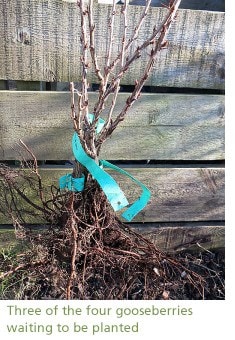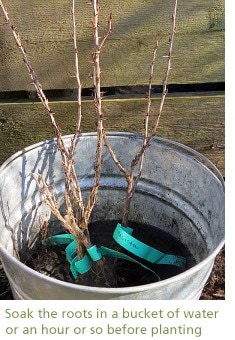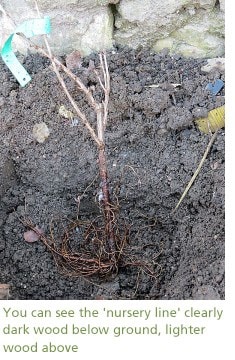Planting bare root fruit
 Last chance saloon for planting bare root fruit this month – which is as good an excuse as I know to blow a small fortune on a fat package of dead brown twigs.
Last chance saloon for planting bare root fruit this month – which is as good an excuse as I know to blow a small fortune on a fat package of dead brown twigs.
Not that it was a fortune when you consider they’ll keep me in gooseberries, jostaberries and tayberries well into my dotage. And the twigs weren’t, of course, dead: merely sleeping.
I have argued endlessly with myself over what exactly to fill my little 25 x 25ft potager garden with ever since I built it, in the way you do when you have a limited space which must supply your every need. Plus, being fruit and therefore a permanent crop, this is a long-term commitment and whatever I chose I was going to be stuck with for decades. So you can see why I wanted to get it right.
Also when it comes to soft fruit I am very insistent on planting things with roots unencumbered by pots, which means I have to wait till winter comes around before I can do the next bit, as that’s the only season bare-root fruit is available.
There is good reason for all this extreme patience. You get a better choice of bare-root fruit than container-grown: not that it’s always a good thing when you’re dithering like a good’un already, but it’s nice to think you’ve chosen the very best there is.
 And bare root fruit are delivered fast asleep, having been rudely dug up from some windswept field somewhere in the middle of their long winter slumber. If all goes well they will continue snoozing right through the transplanting process, only waking up in spring to find themselves somewhere completely different: hopefully, though no doubt disorienting and confusing, they will also find it to their liking since my little fruit garden is neither windswept nor rude but very cosy and sheltered and just as a fruit bush likes it (if you overlook the slightly over-alkaline soil).
And bare root fruit are delivered fast asleep, having been rudely dug up from some windswept field somewhere in the middle of their long winter slumber. If all goes well they will continue snoozing right through the transplanting process, only waking up in spring to find themselves somewhere completely different: hopefully, though no doubt disorienting and confusing, they will also find it to their liking since my little fruit garden is neither windswept nor rude but very cosy and sheltered and just as a fruit bush likes it (if you overlook the slightly over-alkaline soil).
Planting bare root fruit is a straightforward, if slightly chilly process. Here’s how:
1) Unwrap the roots from their packaging as soon as they arrive. They may be asleep, but they’re still alive and don’t appreciate suffocating inside plastic bags any more than we do.
2) The ground will almost certainly be either frozen or waterlogged when your bare root fruit arrive, since this is Winter and therefore Unforgiving. So if you can’t plant your bare roots straight away, find a corner of your garden which isn’t frozen or waterlogged and heel them in till things improve: this just means digging a rough trench, popping the roots in and covering them loosely with soil.
 3) Once you’re ready to plant, plonk all the roots in a bucket for an hour to soak up as much water as possible, so that when you put them in the ground they’re already nice and plump.
3) Once you’re ready to plant, plonk all the roots in a bucket for an hour to soak up as much water as possible, so that when you put them in the ground they’re already nice and plump.
4) Dig a hole rather wider than you think you’ll need, and a little shallower: the idea is to spread the roots out sideways but to plant only as deep as the plant was originally in the ground.
 5) I don’t add anything extra to my soil when I plant: the theory these days is that if you do, you encourage the roots to stay in their nice enriched hole rather than stretching out to explore the wider environment. If your soil is below par, improve it generally – barrowloads of well-rotted manure, you know the drill – before you start.
5) I don’t add anything extra to my soil when I plant: the theory these days is that if you do, you encourage the roots to stay in their nice enriched hole rather than stretching out to explore the wider environment. If your soil is below par, improve it generally – barrowloads of well-rotted manure, you know the drill – before you start.
6) Spread out the roots in the hole so they sit comfortably and backfill. I like to hold the stem just at the point where I want it to sit in the soil and work the soil around the roots with my other hand so I know there are no gaping air pockets. You can see the level where the plant originally sat in the soil – it’s where the dark wood of the roots meets the paler stem above ground – so aim to have that at soil level after you’ve transplanted, too.
7) Finish off by firming gently, giving it all a good water. Sprinkle with slow-release fertiliser and tuck them up with a mulch of compost to slumber for a while longer. They’ll wake up and stretch out a flurry of new leaves in about a month or so from now – you’ll get some berries this year, but stay patient and you should be eating bowlfuls of luscious little juicy jewels from next summer onwards.



 Last chance saloon for planting
Last chance saloon for planting  And
And  3) Once you’re ready to plant, plonk all the roots in a bucket for an hour to soak up as much water as possible, so that when you put them in the ground they’re already nice and plump.
3) Once you’re ready to plant, plonk all the roots in a bucket for an hour to soak up as much water as possible, so that when you put them in the ground they’re already nice and plump.
 5) I don’t add anything extra to my soil when I plant: the theory these days is that if you do, you encourage the roots to stay in their nice enriched hole rather than stretching out to explore the wider environment. If your soil is below par, improve it generally – barrowloads of well-rotted manure, you know the drill – before you start.
5) I don’t add anything extra to my soil when I plant: the theory these days is that if you do, you encourage the roots to stay in their nice enriched hole rather than stretching out to explore the wider environment. If your soil is below par, improve it generally – barrowloads of well-rotted manure, you know the drill – before you start.
